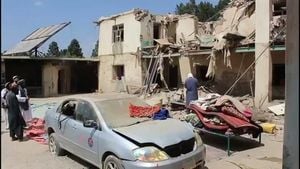Patients suffering from rare diseases across India have penned an urgent letter addressed to Prime Minister Narendra Modi and Health Minister JP Nadda, shedding light on significant challenges associated with the National Policy for Rare Diseases (NPRD) 2021. The letter emphasizes the struggles faced by patients and their families due to the abrupt discontinuation of treatments once the one-time funding of ₹50 lakh is exhausted.
According to the letter, drafted by key representatives from the patient advocacy community, the National Policy for Rare Diseases was seen as a progressive move aimed at improving healthcare access for those suffering from conditions often ignored due to their rarity. “We, the undersigned Patient Advocacy Groups (PAGs), write to appeal for your urgent intervention to address the implementation gaps within NPRD 2021,” they declared.
Alarmingly, the letter highlights data indicating 30% of children diagnosed with rare diseases do not survive past their 5th birthday without timely diagnosis and treatment. Chronic genetic disorders impose life-threatening challenges, particularly among young demographics. This stark reality remains overshadowed by inadequate support and the slow rollout of necessary healthcare programs.
“While NPRD 2021 has been commendable, gaps in its application have left many patients without adequate support. The challenges include discontinuation of treatment once the financial support runs out, limited access to life-saving therapies, and significant delays in the proposed national program,” explained Prasanna Shirol, Co-founder and Board Director of Organisation for Rare Diseases India (ORDI), who was among the signatories of the letter.
Patients have pointed out the urgency of addressing these deficiencies, citing their inability to secure sustainable funding, which is currently capped at ₹50 lakh for chronic, ultra-rare disorders. The letter formally requests the government to remove this financial ceiling and establish transparent, sustainable funding mechanisms to provide uninterrupted treatment, especially for well-documented conditions.
“Approximately 38 patients from three Centers of Excellence (CoEs) have been running pillar to post after exhausting their one-time financial support,” the letter states, highlighting the bureaucratic hurdles the families face, which result in severe financial distress. The families are desperate, experiencing immense financial strain without alternative funding sources to support life-saving treatments.
The letter also urges the Ministry of Health to resolve procurement delays and streamline fund disbursements at CoEs, ensuring patients do not suffer interruptions to treatments like Enzyme Replacement Therapy (ERT), which has proven benefits for conditions such as Gaucher and Fabry diseases. It also advocates for the inclusion of Acid Sphingomyelinase Deficiency (ASMD) under the NPRD to expand the scope of support.
Despite the appeals from patient advocacy groups and the courts, which ordered the release of funds and establishing the National Fund for Rare Diseases (NFRD) with ₹974 crore allocated for the next two fiscal years, there has been little governmental action. The delay has led to increasing despair among families of rare disease patients.
Further compounding the healthcare scenario, the Ayushman Bharat Yojana (ABY), which aims to provide free medical treatments of up to ₹5 lakh per year at empaneled hospitals, has been made available to eligible beneficiaries. Yet, as of now, awareness and accessibility issues remain, complicate the overall healthcare ecosystem.
Eligible individuals can apply for the Ayushman Card either online, through the official website pmjay.gov.in, or offline via local Common Service Centers (CSCs). The system is reasonably straightforward, but many still remain unaware of the procedures to verify their eligibility and application processes, potentially leaving some without needed coverage.
“Ayushman Bharat Yojana is intended to lessen financial burdens on healthcare for lower-income groups, but discrepancies exist. Awareness and application procedures need to be simplified for broader outreach,” health experts caution.
With systematic reforms necessary to address the gaps highlighted by patients and advocacy groups, there is hope for progress if both the government and the healthcare community take serious action toward implementing the recommendations outlined. The voice for equity and access to healthcare among the rare disease community continues to resonate, urging leaders to commit to nurturing the health of all citizens.



